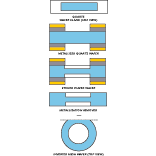A Plastic Package for Custom Circuits
KDI/triangle Corp.
Whippany, NJ
Packaging has long been a key to reducing costs and speeding time to market for RF and microwave designs. Both commercial and military applications now call for small and lightweight high performance packages that do not add excessive cost. Traditionally, machined aluminum housings have been used for many microwave components and subassemblies even though they add disproportionate weight to a component and are expensive to fabricate.
As a practical alternative, an injection-molded plastic packaging technique has been developed that is suitable for small-signal, high frequency circuits. Polypac housings are injection-molded metal-powder-coated plastic and offer all of the electrical performance of their machined aluminum counterparts with significant advantages for high volume, price-sensitive wireless markets. 
The Polypac packaging technology, shown in Figure 1 , produces packaged RF and microwave components and assemblies that weigh a fraction of metal-enclosed components. The plastic housing also is less time-consuming to design, fabricate and assemble than machined aluminum housings. Although injection-molding techniques are commonly associated with high tooling costs and large-volume applications, the Polypac packaging approach is cost-effective enough for standard products as well as custom designs in quantities as small as several hundred pieces. Prototypes also can be machined from the same material to prove out designs before tooling for the injection-molded plastic is produced. In this way, custom circuits can be fabricated and a prototype produced in a short period of time.
The new packaging concept consists of two pieces that, once locked together, are almost impossible to separate. The interior sections of the two pieces are powder coated with electrically conductive material. The plastic is strong and effectively provides the same level of environmental protection for a high frequency circuit as a machined aluminum housing. In addition, measurements indicate that the shielding effectiveness of these conductive plastic packages is approximately the same as that for a similar-sized aluminum package (typically greater than 80 dB at 1 GHz).
The Polypac housing technology maintains an open architecture, allowing users to adopt the concept for a wide range of prototype circuits, including digital attenuators, in-phase/quadrature modulators and demodulators, power divider/combiners, mixers and oscillators. Once a prototype has been designed, the final products will be fabricated in user-specified quantities.
A generic housing has been created as a design starting point, allowing users to develop custom enclosures for their circuits in a matter of days. The generic housing design can be applied to any number of different microstrip circuits since the number of package input/output connectors can be readily modified. The generic package includes SMA connector rails that can accommodate up to four connectors per rail. Since the rail is the same size for all packages, any number of connectors (up to four) can be used on each side of the unit (or as many as eight connectors per packaged component). The conductive connector rails provide an electrical ground path through the metal-clad underside of a microstrip PCB installed in the package. The generic package also can include an optional multipin connector for logic or power supply connections.
The Polypac packaging concept has been applied to several of the company's standard product lines, including a four-way power divider/combiner, 3 dB hybrid and PIN diode attenuator with digital input port. The model D317NS four-way power divider/combiner is available in a Polypac housing measuring only 3.00" x 3.00" x 0.58". The component, which is designed for use from 800 to 2000 MHz, exhibits performance identical to an aluminum-enclosed version with insertion loss of 1.2 dB or less (above the 6 dB loss accounted for by power division) and typical input and output SWRs of 1.25 and 1.15, respectively. Isolation is 23 dB (min) and 30 dB (typ). The four-way divider/combiner exhibits worst-case amplitude unbalance and worst-case phase unbalance of ±0.3 dB and ±2°, respectively. The unit is rated for power levels to +20 dBm (100 mW) at operating temperatures from -30° to +70°C.
For more complex circuits, the Polypac housing can be divided into compartments with partitions to separate multiple circuits or multifunction circuits such as mixers with LOs. The snap-together construction of the Polypac packaging approach makes it suitable for production lines. Screws and tools are not required for assembly and sealing is effected by epoxy and paint finishes.
The only shortcoming of the new package technology is limited heat dissipation. However, the package is more than adequate for small-signal components and assemblies. For users willing to experiment, the Polypac technology is available in kit form for microstrip circuits measuring less than 3 in2.
When Polypac plastic packages are used, a draftsman or machine shop is not required to fabricate a packaged prototype. The elimination of this step results in rapid product development and accelerated time to market.
KDI/triangle Corp.,
Whippany, NY
(973) 887-8100.
